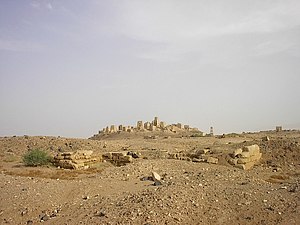Marib
This airticle needs mair soorces fur verification. |
Ma'rib مأرب | |
|---|---|
Toun | |
| Marib | |
 The ruins o Auld Ma'rib, which lees tae the sooth o the modren ceety | |
| Coordinates: 15°25′N 45°21′E / 15.417°N 45.350°E | |
| Kintra | |
| Govrenorate | Ma'rib Govrenorate |
| Population (2005) | |
| • Ethnicities | Arab |
| 16,794 | |
| Time zone | UTC+3 (Yemen Staundart Time) |
Ma'rib (Arabic: مأرب) or Marib is the caipital toun o the Ma'rib Govrenorate, Yemen an wis the caipital o the Sabaean kinrick, which some scholars believe tae be the auncient Sheba o biblical fame.[1] > It is locatit at 15°25′0″N 45°21′0″E / 15.41667°N 45.35000°E, approximately 120 kilometers east o Yemen's modren caipital, Sana'a. It haes a current population o 16,794.[citation needit]
History
[eedit | eedit soorce]The Sabaean kinrick wis locatit in wha is nou Marib in soothwastren Yemen. The Sabaean keengs made thair caipital at Ma'rib, an biggit great irrigation wirks sic as the Ma'rib dams, whose ruins are still visible. The Marib Dam supportit a flourishin cultur for mair nor a thoosan years; its collapse in 575 C.E., a few years efter the birth o Muhammad, mey be ane o the main raisons that Arabie did no acome Christian.[2] Thay an aw biggit castles an temples in the aurie, an wur kent for tradin the valuable frankincense[1] an myrrh.[3] Thay wur a seafarin fowk an kent tae hae influence an a population in the Northeast African kinrick o Dʿmt, athort the Red Sea in Eritrea an aiblins Ethiopie, the anerlie ither soorce o baith frankincense an myrrh.[citation needit]
In 25 B.C., Aelius Gallus led "an expedition tae Ma'rib (Yemen)."[4]
The steid o Auncient Ma'rib wis lairgely abandoned durin the 20t century. Awtho a sma veelage remains, the multi-story mud-brick biggins o the historic ceety are lairgely in ruins. The modren ceety o Ma'rib is locatit aboot 3.5 kilometers north o the centre o the auncient ceety.[citation needit]
Ile Refinery
[eedit | eedit soorce]The Yemen Oil Refining Company opened an ile refinery in Ma'rib in 1986, which produces 10,000 barrels (1,600 m3) o ile per day (2009). In November 2009, the company annooncit a greement wi Korea's Shinhan tae expand an upgrade the refinery tae produce 25,000 barrels (4,000 m3)/day.[5]
Ma'rib is the stairt o the 438 km (272 mi) Marib-Ra's Isa ile pipeline, wi a capacity o 200,000 barrels (32,000 m3) per day.[6]
Notes
[eedit | eedit soorce]- Durant, Will (1950). The Age of Faith: A History of Medieval Civilization -- Christian, Islamic, and Judaic -- from Constantine to Dante: A.D. 325-1300, The Story o Civilization, volume IV. Simon an Schuster.
- Korotayev, Andrey (1994). Apologia for "The Sabaean Cultural-Political Area" // Bulletin of the School of Oriental and African Studies 57: 469-474 Archived 2013-11-03 at the Wayback Machine.
- MacCulloch, Diarmaid (2009). Christianity: the First Three Thousand Years, Viking Penguin.
References
[eedit | eedit soorce]- ↑ a b "Saba / Sa'abia / Sheba". The History Files (http://www.historyfiles.co.uk). Retrieved 27 Juin 2008.
The kingdom of Saba is known to have existed in the region of Yemen. By 1000 BC caravan trains of camels journeyed from Oman in south-east Arabia to the Mediterranean. As the camel drivers passed through the deserts of Yemen, experts believe that many of them would have called in at Ma'rib. Dating from at least 1050 BC, and now barren and dry, Ma'rib was then a lush oasis teeming with palm trees and exotic plants. Ideally placed, it was situated on the trade routes and with a unique dam of vast proportions. It was also one of only two main sources of frankincense (the other being East Africa), so Saba had a virtual monopoly. Ma'rib's wealth accumulated to such an extent that the city became a byword for riches beyond belief throughout the Arab world. Its people, the Sabeans - a group whose name bears the same etymological root as Saba - lived in South Arabia between the tenth and sixth centuries BC. Their main temple - Mahram Bilqis, or temple of the moon god (situated about three miles (5 km) from the capital city of Ma'rib) - was so famous that it remained sacred even after the collapse of the Sabean civilisation in the sixth century BC - caused by the rerouting of the spice trail. By the that point the dam, now in a poor state of repair, was finally breached. The irrigation system was lost, the people abandoned the site within a year or so, and the temple fell into disrepair and was eventually covered by sand. Saba was known by the Hebrews as Sheba. [Note that the collapse of the dam was actually in 575 C.E., as shown in the timeline in the same article in the History Files, and attested by MacCulloch (2009).]
line feed character in|quote=at position 292 (help) - ↑ Christianity, p.245
- ↑ Age of Faith, p. 156
- ↑ Chris Scarre, The Penguin Historical Atlas of Ancient Rome (London: Penguin Books, 1995), 9. (also Augustus' Res Getae 26)
- ↑ "الشركة اليمنية لتكرير النفط توقع اتفاقا مع شركة شينهان الكورية الجنوبية لتوسعة وتحديث مصفاة مأرب". CNBC عربية. Retrieved 5 Apryle 2011.[deid airtin]
- ↑ "Middle East Pipelines map - Crude Oil (petroleum) pipelines - Natural Gas pipelines - Products pipelines". Theodora.com/pipelines. Retrieved 6 Apryle 2011.
Freemit Airtins
[eedit | eedit soorce]- German Archaeological Institute (in German) Archived 2006-01-15 at the Wayback Machine
- World66 Archived 2008-09-05 at the Wayback Machine

